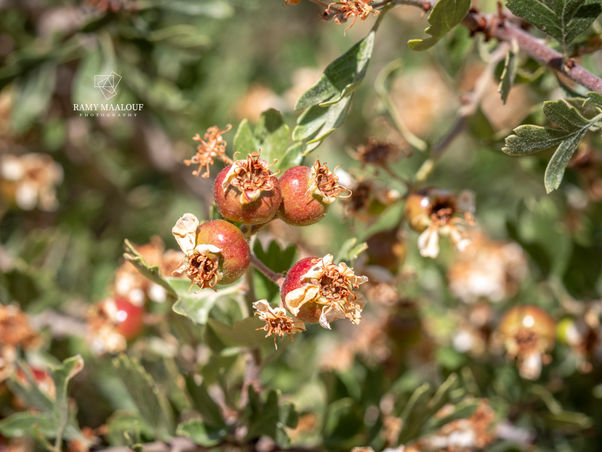Family |
Rosaceae
Crataegus azarolus
L.
Crataegus azarolus L.
(Sp. Pl.: 477, 1753; Nouvelle Flore du Liban et de la Syrie, vol. 2, p. 574; Pl. CCL nº 1; 1966)
• Life-form & habit: Small tree or large shrub, up to 6–8 m, much-branched, armed with stout thorns. Crown dense, rounded.
• Leaves: Variable, 2–6 cm, broadly rhomboid in outline, irregularly lobed with 3–5 triangular lobes, coarsely toothed; base cuneate, petiole slender; both surfaces glabrous or slightly pubescent.
• Inflorescence & flowers: Corymbs many-flowered; pedicels pubescent. Flowers 12–18 mm across, petals white, orbicular; calyx lobes triangular, acute, pubescent; stamens 18–20, anthers pink; styles usually 2–3.
• Fruit: Pome globose to oblong, 1–3 cm, yellow to orange-red, crowned by the persistent calyx lobes; flesh edible, mealy-sweet.
• Phenology: Flowers April–May; fruits ripen August–September.
• Habitat & elevation: Open woodlands, scrub, rocky slopes, often cultivated and naturalized; 0–1,500 m.
• Lebanese distribution: Common throughout Mount Lebanon, Anti-Lebanon, and Beqaa; reported from Bcharré, Barouk, Zahlé, Baalbeck, Rachaya, and Hermon.
• Syrian distribution: Widely scattered — Damascus, Hauran, Palmyra, Aleppo, and coastal mountains.
• Native range: Algeria, Baleares, Cyprus, East Aegean Islands, Egypt, France, Greece, Iran, Iraq, Italy, Kriti, Lebanon–Syria, Libya, Palestine, Sardegna, Sicilia, Sinai, Transcaucasus, Tunisia, Turkmenistan, Turkey, Turkey-in-Europe (POWO).
• Introduced into: Morocco, NW. Balkan Peninsula, Spain (POWO).
• Doubtfully present: NW. Balkan Peninsula (POWO).




